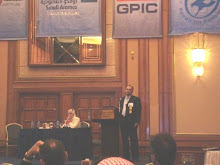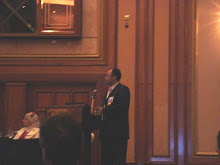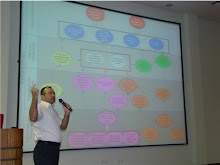Upon building trust, partnering uses group based processes focusing on Deming’s 80-20 rule to:
• Focus all stakeholders on shared values and objectives
• Focus on identifying the dominant problems and opportunities
• Establish benchmarks
• Develop action plans for problems and opportunities
• Develop performance feedback system to measure performance against objectives.
• Provide feedback to all and adjust accordingly.
Stakeholders gather and establish their vision of a perfect project; their objectives for the particular project, problems that will stop the project from achieving its goals, and finally develop their own processes to manage the project (as shown in figure below). All stakeholders are respected and it’s the project processes that hinder achieving the objectives.
Six-Phase Model for Partnering Integration
A six-phase model is used to integrate partnering as a strategy and implement it, these are:
Phase 1: Owner’s internal alignment
Phase 2: Partner Selection
Phase 3: Partnering relationship Alignment
Phase 4: Project Stakeholder Alignment
Phase 5: Transition
Phase 6: Development.
Symbols for Others to Follow
Adopting the above approach will enable using successful projects to create symbols for new values that afterwards form the new organizational cultural values. Culture is here used to drive organizational change until partnering values become at the deepest level of the organizational culture.
Cultural Change Process
Uses Propaganda and symbols that affects emotions rather than traditional training.
Organizational cultures are formed through four phases these are Vision, Proof, Confirmation and Internalization.
There are also four rules for adding to organizational existing culture(Gagliardi, 1986) which should be considered:
1. No conflict with old values
2. Organization experience success collectively
3. Leadership promotes success and symbolizes it
4. Structured hierarchy of values
Gagliardi’s Approach- Slow Incremental change to Organizational Culture
Addressing the cultural issues should start with the fact that culture is held behaviorally (not logically) in the primitive part of our brain and are exceptionally difficult to change. Gagliardi presents culture as consisting of two distinct levels (values upon which practices are based). As shown in fig. below, changes will be incremental; we slowly introduce new practices that can -after some time- shift the deeply values. A Directly proportional relation exists between change difficulty on one hand and culture strength, level of change and misalignment with existing values on the other.
Kotter and Heskett research suggested that culture’s resistance to change results from four characteristics of organizational culture:
1. Interdependencies between the two cultural levels;
2. The strong connection of values to human emotions (should feel the need for change);
3. Interdependence between culture and pluralism (powerful defend their power);
4. Normative actions based on past successes (lost cause and effect relationship).
About The Author

- Eng. Samer el Barakeh, MPM, PMP
- Samer el Barakeh was born in Lebanon, 1973. He completed his Bachelor in Engineering-CCE at Beirut Arab University-Lebanon in 1996 with honours. Samer was granted Masters Degree in Project Management (MPM) from the University of Sydney-Australia with honours. He also gained the Project Management Professional (PMP) Credential from The Project Management Institute (PMI). Samer is a member of the Order of Architects and Engineers in Lebanon since 1996, The Project Management Institute (PMI), Arabian Gulf Chapter (AGC-PMI) and Lebanon Chapter-PMI. During his 13 years of professional experience in Lebanon, Australia and Saudi Arabia, Samer held many positions among them: Telecommunication Site Engineer, Site Manager, Low Current Service Head, and he is currently Senior Systems Analyst at the General Project Construction Division. Samer is a Project Management Consultant and Training Provider for universal organizations like Business Management Consultants (USA) www.bmc-online.com and PMCTQuest (Canada) www.pmctquest.com Samer is a Registered Training Provider for Project Management Professional (PMP), and he provides training in Program Management, Portfolio Management,PMO...
Select a topic to view content
- A comparison between PMBOK and Prince2 Methodologies and reflection on case study examples (1)
- ABC to Avoid Project Failure (1)
- Business Case and Quantitative Benefits (1)
- Do we need more 'Planners' ? (1)
- Fasilitator in Partnering-A Coincise Shot (1)
- How to Ensure Stratgic Alignment of Our Projects? (1)
- Individual Dissimilarity and Team Work (1)
- Knowledge Management (1)
- Maturity Models-The Pros and Cons (1)
- Organizational Advantages from Partnering (1)
- Organizational Maturity: Lets Head Upwards... (1)
- Organizational Strategy and Project Alignement (1)
- Practical Solutions 1 of 6: Introduce RMMM (1)
- Practical Solutions 2 of 6: Facilitate Change to Perk up Maturity (1)
- Practical Solutions 3 of 6: Leverage Organisational Culture Barrier (1)
- Practical Solutions 4 of 6: Organisational Cultural Alignment (1)
- Practical Solutions 5 of 6: Defining a Unified Decision Making Tool (1)
- Practical Solutions 6 of 6: Understanding The Paradox of Control (1)
- Programme Management to Implement Strategy (1)
- Project Management and Construction Management (1)
- Project Managers relocated before Proper Project Closure and Learning Lessons (1)
- Project Managers' Power (1)
- Strategic Planning (1)
- Successful Project Management Office-PMO (1)
- System Thinking: Archetypes at Work... (1)
- The Partnering Change Process (1)
- The Upper Hand… Leadership skills or Processes? (1)
- Thinking about change needed? Maybe you should be more ‘worried’ about how to make it real (1)
- Vision Mission and Objectives What and Why? (1)
- What is meant by Portfolio and Programme Management (1)
- Why Partnering in Organizations? (1)
February 21, 2008
The Partnering Change Process
Posted by
Eng. Samer el Barakeh, MPM, PMP
at
12:44 PM
0
comments
![]()
![]()
Labels: The Partnering Change Process
Fasilitator in Partnering, A Coincise Shot
The Role of Facilitator in Partnering:
The process has to be owned by stakeholders; the facilitator should be neutral and mutually agreed upon. He/she manages the meeting process only not the content.
Facilitator needs to be:
• ethical
• respect individual
• believes in process consulting
• respects the personal aspect of stakeholders
• respects confidentiality.
There are three Facilitator roles:
• Internal Facilitator: To reduce cost; Only used if stakeholders have previous experience with partnering; should be a small stakeholder to be considered neutral; should work on establishing shared objectives, problem identification and develop action plans and NOT team building activities.
• External Facilitator-Single Project: when stakeholders are new to partnering, the emphasis is on establishing trust and team building, and the ongoing partnering process. When they become experienced, emphasis shifts to continuous improvement of both the project and partnering process.
• External Facilitator-Strategic Partnering: for organizational change projects and contracting out-performance measurement projects.
Key Skills Required:
Networking
Interpersonal skills
Cross-cultural skills
Team building
Organizational design and change management
Project management
Posted by
Eng. Samer el Barakeh, MPM, PMP
at
12:05 PM
0
comments
![]()
![]()















